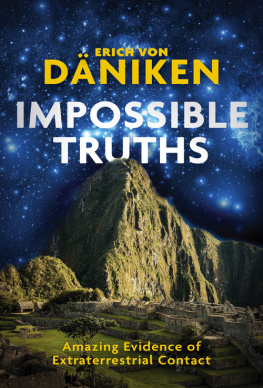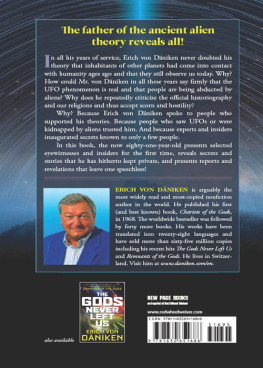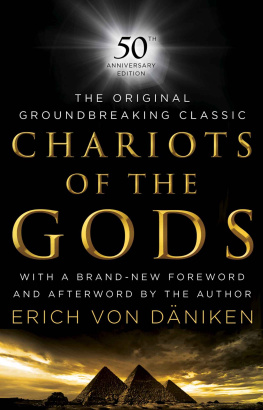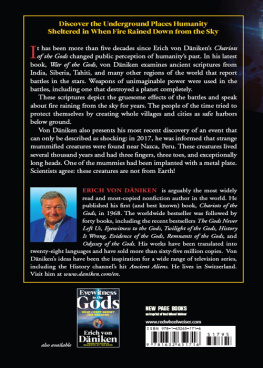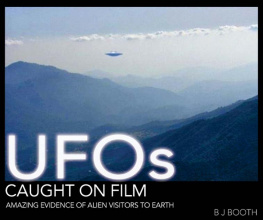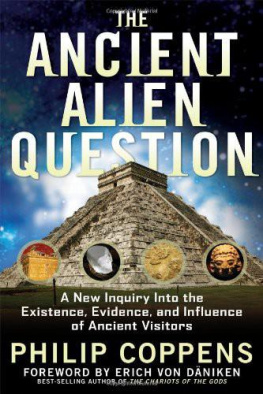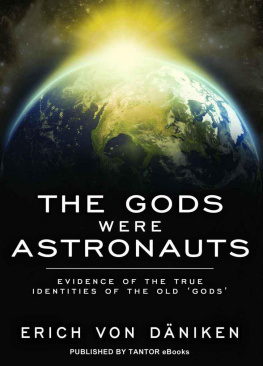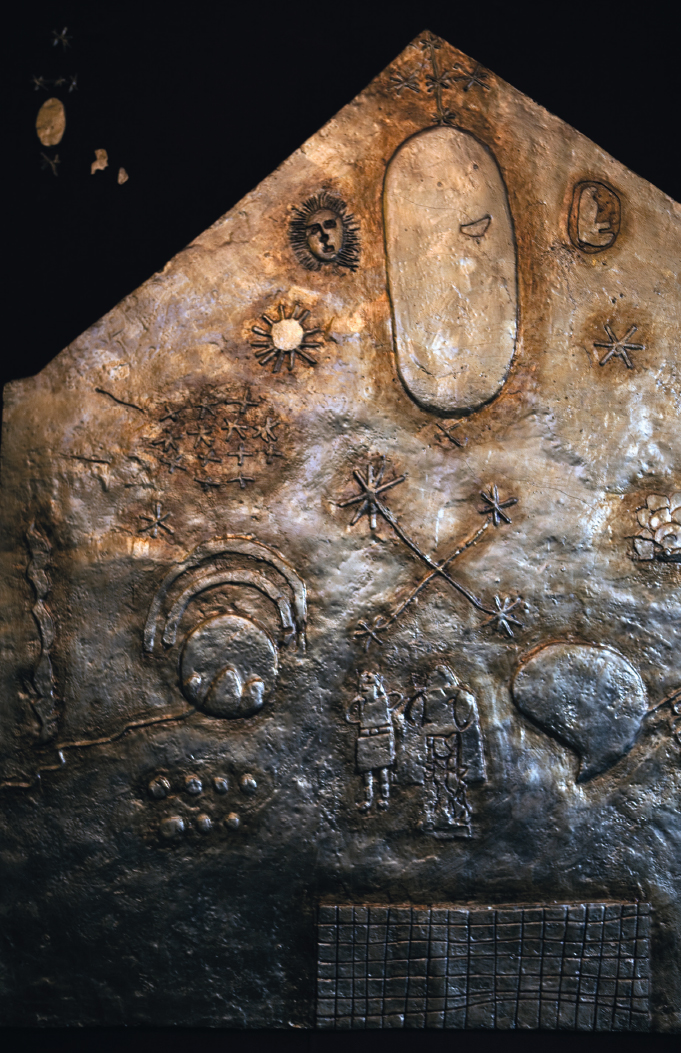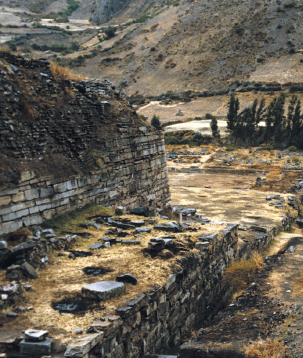IMPOSSIBLE TRUTHS
ERICH VON
DNIKEN
IMPOSSIBLE TRUTHS
Contents
A LETTER TO MY READERS
My book Chariots of the Gods? [102] came out in 1968, some 50 years ago now. It was then that I shook for the first time the edifice of history, archaeology and religion that has been built up over the millennia. Why, I asked, do the artwork and sacred texts of ancient cultures all over the globe appear to depict flying craft and astronauts? How could the medieval Piri Reis map show Earth as our planet is seen from space? What of the prehistoric artefacts that include electrical batteries and cut-crystal lenses that today could only be manufactured by complex electro-chemical processes? What of the cave drawings that replicate with astonishing precision the exact position of the constellations as they were 10,000 years ago? All the evidence pointed in one direction: visitors from other parts of the universe must have brought their technological expertise to Earth in the remote past. The Stones of Kiribati [100] followed in 1981, with The Gods and their Grand Design appearing a year later [101]. Even the comparatively more recent title Arrival of the Gods [49], in which I wrote in detail about the worlds greatest picture book in the Nazca Desert of Peru, is already 20 years old.
My books sold all around the world, but now theres a new generation of readers who dont know about my theories on the inexplicable stone workings at Sacsayhuamn, above the city of Cuzco in Peru, or about Buritaca 200, the mysterious jungle settlement in the Sierra Nevada of Colombia that I was the first to write about. Every day people say to me: Buritaca? Whats that? Sacsayhuamn? Never heard of it. Nazca? Isnt that the UFO place in Mexico?
I tell myself that it is as it is, and I cant expect other people to share my interests or want to engage with the same riddles from the past that fascinate me! And yet ...
I am convinced that people will be just as intrigued as I am in these mysteries if the proof is put before them. All a researcher can do to engage a new generation is to present the evidence once more and add to it where possible. So, what has happened in the decades since my books were first published? How has the picture changed? Have we solved the riddles or have we found new evidence that can take us toward a solution?
The truth is that we still havent solved the riddles. We know today as little as we did 100 years ago about the Tello Obelisk and the Raimondi Stele, both found in the ruins of Chavn de Huntar in Peru. Since I wrote my last books, the jungle city of Buritaca 200 in Colombia has opened up to tourism. And through the research undertaken there, we now know the creation stories of the indigenous Kogi peoples, whose ancestors built the city. We have learned of the four priestgods who came from the far reaches of the cosmos, and who wore masks when they descended to Earth. As with so many other indigenous traditions, the faces of the gods of the Kogi had to be protected from this planets atmosphere.
But what of Nazca? Havent we heard every possible theory on that subject by now? In this book I very briefly outline my ideas about Nazca, for the benefit of readers who havent seen my previous books. Then I let the 38 pictures of Nazca do the rest of the talking for me. Most of these images have never been published before; all of them will take your breath away. It is incredible how much there is to marvel at in the Peruvian desert. And, as I shall explain, nothing at all in these images fits in with the scientific explanations we already have.
Much less well known than Nazcas images are the gigantic earth drawings that exist by the Aral Sea (between Uzbekistan and Kazakhstan), and in Jordan, Saudi Arabia, Chile and Mexico. It would be a mistake to think that Nazca is unique that would be to miss the most exciting part of the story. In fact, Nazca is worldwide, as are the ancient descriptions of flying machines found in so many traditions. The earth drawings that can be seen all over the globe are connected and what connects them is dynamite!
Have you read anything about the meaning of the Tunjo Stones in Colombia? About rocks in Saudi Arabia that have been turned to glass? About a petrified forest in Patagonia, where the logs seem to have been sawn through? Theres nothing surprising about sawn logs, until you realize that the sawing must have occurred millennia ago, at a time when neither saws nor human beings as we know them now existed. Did you know that every culture of ancient times can be shown to lie on a 40,000km (24,000-mile) band running around the world? Did you know that Nazca is exactly as far from Giza in Egypt as Giza is from Teotihuacn in Mexico? Or that the distance from Angkor Wat in Cambodia to Nazca is the same as the distance from Mohenjo-Daro in Pakistan to Easter Island in the South Pacific? There is much to think about here!
The world of the distant past is amazing. Studying the archaeological evidence changes our perceptions, raises new questions and throws into doubt the natural course of evolution.
Of course evolution exists but thats not all there is.
I invite you now to open your mind and immerse yourself in a world of impossible truths!
Yours,
Erich von Dniken
CHAPTER ONE:
From Peru to Jerusalem
On 18 April 1980, I visited the archaeological site at Chavn de Huntar in Peru with three companions. Months before, I had read something in a magazine about this place, a mysterious temple of an unknown culture. I studied a map and worked out that Chavn de Huntar was somewhere high up in the Andes.
That April, I rented a car and at the crack of dawn drove out of Lima on the Panamericana del Norte in the direction of Trujillo, the third most populous city in Peru. In the small town of Pativilca, I turned right toward the mountains. The ascent out of the rusty brown canyon begins in a series of tight serpentine bends and makes a seemingly endless climb to a height of 2,600m (8,500ft) and the last gas station at Cajacay. The road takes you a further 80km (50 miles) to the village of Catac, from where the road becomes a steep, dirt track that leads up to the icy mountain lake of Quericocha. Then, at an altitude of 4,510m (14,800ft), you enter the tunnel of the Kahuish Pass. I say tunnel, but this is no slick alpine thoroughfare as you would get in Europe. Some 500m (1,650ft) long, the Kahuish Pass is roughly hewn from the mountain rock and full of deep potholes, with glacier water edging its way, half-frozen, down the passage walls. Once through the tunnel, theres a steep descent into the Mosna Valley. The dirt road winds its way downward, one curve curling into another, like an endless snake. You learn to avert your eyes, because a deadly chasm threatens over the edge of the road. At the tiny village of Machac (at 3,180m/10,400ft) you finally reach the valley floor. The ruins of the village complex of Chavn de Huntar lie neglected by the side of the road.
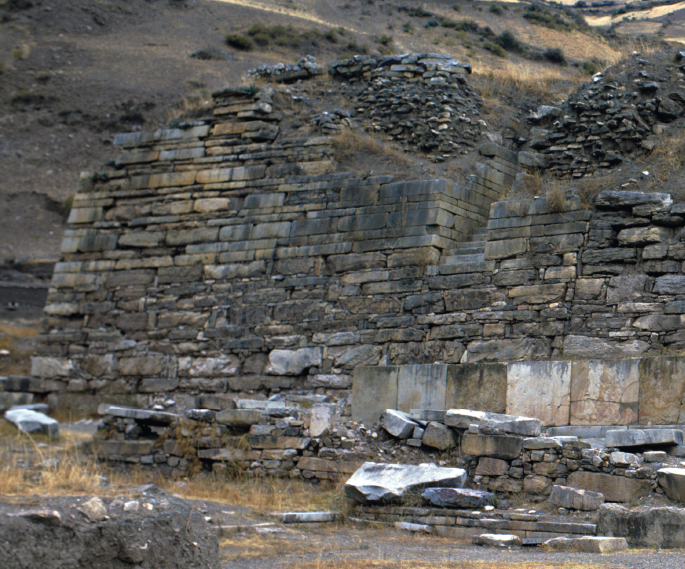
Figure 1: The principal structure at Chavn de Huntar, Peru.
Figure 2: Chavn de Huntar in the Mosna Valley.
Next page
